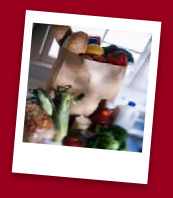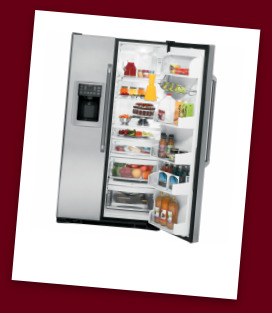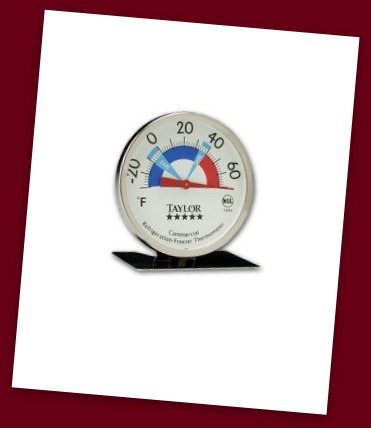|
Storing Food SafelyHome Storage Practices
Unhappily, storage is one of the most ignored and unappreciated of food safety measures.
Has this ever happened to you? You pull into the driveway, car loaded up with groceries. You bring the bags into your kitchen and set them on the counter… and the phone rings. You talk, hang up, and – since you’re standing there – you check the answering machine and make a return phone call. Then you run out to the mailbox and find a letter you’d been hoping to receive for some time. You sit down to read it and answer it…. Finally you realize that – oh, yes! – your food is still sitting there waiting for you to put away.
Putting food away safely must be a priority!
Now, as a reader if this web site, you’re smart when you shop (check out our grocery store guidelines), so you’re bringing home good-quality, wholesome food. The trip home, however (especially if it’s a long one), can raise food temperatures to a point where germs start to grow. Keep that in mind. Try to plan your shopping so your food gets home quickly. It’s a good idea to do your other errands first, and your grocery shopping last. If that isn’t possible, or if you have a long ride home, a cooler in your car’s trunk for frozen and cold food items might be a good investment. Collapsible coolers are available that can let you use your trunk space efficiently. Some grocery stores will also give you a small amount of dry ice to help keep your food cold – just ask!
Bring the food inside and put it away quickly. Start with the unfrozen but cold items – for instance, meats, cheeses, and eggs. Then do the frozen things, and finally put away your shelf-stable (dry) foods like cans, mixes, and bakery items.
Where should it all go?
The principles that restaurants and groceries follow are actually best practices, however. They may not completely work for you, but adapt them to your own equipment as best you can.
With this in mind, think about how to put these practices into effect for your family. You’ll find that your food stays fresher, longer, and you’ll save money on your food budget.
What storage temperatures are best?
Germs enjoy what we call “room temperature” (65-72 ˚ F, 18.8-22.2 ˚ C), but they can grow in lower and higher temperatures as well. We know that below 41 ˚ F (5 ˚ C), growth is slowed down to little or nothing (although some germs can grow when they’re this cold, and some even survive freezing temperatures!). You want to keep your food out of the temperatures that germs like (in food safety terms, the Temperature Danger Zone, or TDZ for short).
Store your dry goods in a cabinet or pantry. It is always a good idea not to leave food on the floor. Most areas of the world have bugs and critters looking for lunch. They consider floor-level food an open invitation, and they bring with them germs and other things you don’t want in your breakfast. So keep all food storage off the floor. A cabinet or shelf is best.
It’s also a good idea to keep your dry foods out of sunlight; they do best in a dry, cool, closed cabinet or pantry. Sunlight can heat up canned items and cause them to go bad faster than you would expect.
- How long can this food last?
Great question. It depends on how good it was when you bought it and how well you’ve stored it.
How long? Check the manufacturer’s expiration date if you haven’t opened the package. If that’s OK, you should be OK. If you’ve opened it and want to know how long it’s safe to use, check out this excellent link:
Well, we purchased the food, we stored the food, we prepared the food, we cooked the food, and now we have to learn about leftovers! Do you remember everything that you should do?
Decided that you’d rather go out to eat? Click here for things you should know!
Are you brave enough to find out how food spoils? Click here.
|






 Restaurants have strict regulations for storing food to keep it safe (even stating what shelf to put what items on), but most restaurants have pretty large coolers to store all their food supplies. You probably don’t have a giant walk-in cooler or freezer in your home. Most families have a refrigerator and freezer of some size; some might even have a separate freezer as well.
Restaurants have strict regulations for storing food to keep it safe (even stating what shelf to put what items on), but most restaurants have pretty large coolers to store all their food supplies. You probably don’t have a giant walk-in cooler or freezer in your home. Most families have a refrigerator and freezer of some size; some might even have a separate freezer as well.  The best temperature for your refrigerator is 36 to 40 ˚ F (2.2 to 4.4 ˚ C). Keep your freezer ideally at 0 to 10 ˚ F (-17 to -12 ˚ C). How do you know if your appliances are at the right temps? Here are a couple of ways to check:
The best temperature for your refrigerator is 36 to 40 ˚ F (2.2 to 4.4 ˚ C). Keep your freezer ideally at 0 to 10 ˚ F (-17 to -12 ˚ C). How do you know if your appliances are at the right temps? Here are a couple of ways to check:  The basic principle is always to use your best judgment. Just be sure your judgment is as good as you can make it (what’s why we’re here). Back in college, my roommate decided that the milk didn’t taste THAT bad, and he claimed that the date on the carton didn’t matter. He ended up with a bad case of diarrhea (not that he shared that tid-bit of info with me - you just knew). Back then we all “did what was right in our own eyes” – I just remember him visiting the bathroom a lot for the rest of the day!
The basic principle is always to use your best judgment. Just be sure your judgment is as good as you can make it (what’s why we’re here). Back in college, my roommate decided that the milk didn’t taste THAT bad, and he claimed that the date on the carton didn’t matter. He ended up with a bad case of diarrhea (not that he shared that tid-bit of info with me - you just knew). Back then we all “did what was right in our own eyes” – I just remember him visiting the bathroom a lot for the rest of the day! 
